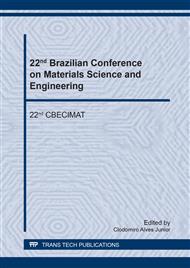p.107
p.115
p.120
p.125
p.131
p.137
p.142
p.148
p.153
Sericitic Phyllite as Addition in Portland Cement
Abstract:
Pozzolans are materials that when milled are able to react with the cement, forming compounds with binder properties. Seeking to reduce costs and improve Portland cement performance, the cement industry has used mineral additions such as pozzolans, partially replacing clinker in Portland cement. Sericitic Phyllite is a metamorphic rock, considered sterile by iron mining. It is extracted from the pit to enable the extraction of iron ore and is disposed in sterile piles, representing an environmental liability. The present work evaluated the possibility of the Sericitic Phyllite acquires pozzolanic properties from thermal treatment, to be used as mineral addition in the partial substitution of Portland cement in mortars. The material was processed by milling in its natural moisture of 8% using a high performance planetary mill, and calcination in an electric resistance furnace at different temperatures (350, 550 and 850oC) for thirty minutes each. It was characterized by laser granulometry, X-ray diffraction (XRD), scanning electron microscopy (SEM) and differential thermal and thermogravimetric analysis (DTA/TGA). After characterization, specimens were prepared with 25% substitution by weight of the Portland cement by the Sericitic Phyllite. The calcined material in 350, 550 and 850oC reached, respectively, 70%, 76% and 82% of the resistance of the control mortar. The results indicate the feasibility of using the Sericitic Phyllite as mineral addition in Portland cements as the mortars with the calcined material in all temperatures reached 32MPa.
Info:
Periodical:
Pages:
131-136
Citation:
Online since:
September 2018
Price:
Сopyright:
© 2018 Trans Tech Publications Ltd. All Rights Reserved
Share:
Citation:


